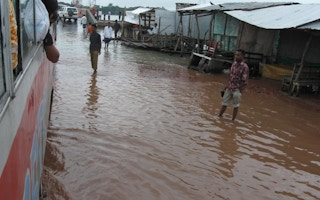Bangladesh will seek to improve the way it communicates flood warnings to local people in regions at risk of rising waters, a minister said on Monday, responding to a report that many flood victims were not alerted by the government earlier this year.
Severe floods, after heavy monsoon rains, displaced nearly 800,000 people and killed at least 60 across Bangladesh in July.
According to a survey of about 700 flood-affected families released on Sunday by Transparency International Bangladesh (TIB), nine-tenths said they were not warned by the government at least 24 hours before the disaster hit them.
Enamur Rahman, Bangladesh’s state minister for disaster management and relief, told the Thomson Reuters Foundation he disagreed with TIB’s figures, but had received complaints about the level of preparedness for the floods.
“We heard from a few areas that the water entered the victims’ homes while they were sleeping and they weren’t warned… This is true to a certain extent,” Rahman said.
He added that it had not been possible to disseminate forecasts of extreme weather to 100 per cent of the public.
“But we had meetings to solve these issues… and I can guarantee that such complaints will never be heard again,” he said, without giving details of how that would be achieved.
He explained that the government currently sends out flood forecasts through its website and local disaster committees, which in turn use volunteers and community radio stations to reach people on the ground.
“
We heard from a few areas that the water entered the victims’ homes while they were sleeping and they weren’t warned… This is true to a certain extent.
Enamur Rahman, minister for disaster management and relief, Bangladesh
Low-lying Bangladesh is extremely vulnerable to climate change threats, including worsening floods. This year’s floods inundated thousands of homes across a third of the country.
A report this month by the London-based International Institute for Environment and Development said rural families spend 12 times more each year coping with climate change impacts than the foreign aid Bangladesh receives for that purpose.
Nearly one in three children in Bangladesh are at risk from cyclones, flooding and other climate change-linked disasters, the U.N. children’s agency said in April.
TIB’s report noted that only 7 per cent of flood survivors interviewed took refuge in government shelters due to “inadequate facilities and poor management”.
Iftekharuzzaman, TIB’s executive director, said the report highlighted problems in how the government implements its plans.
TIB’s suggestions included strengthening the country’s early warning system, repairing embankments before the rainy season, and focusing more on providing shelter facilities that can cater for older and disabled people.
“This report is based on practical experience… I believe that the government will take this into consideration and we will work with them to facilitate the recommendations,” Iftekharuzzaman said.
This story was published with permission from Thomson Reuters Foundation, the charitable arm of Thomson Reuters, that covers humanitarian news, climate change, resilience, women’s rights, trafficking and property rights. Visit http://news.trust.org/climate.










